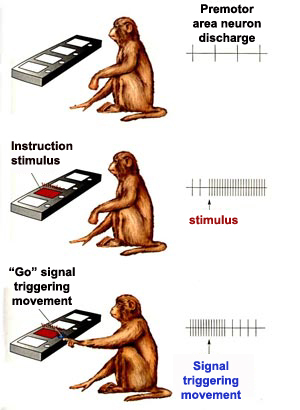Experiment Module: Activity Pattern of Neurons in the Motor Cortex of Monkeys
| One very
instructive way of studying how the brain controls movement is by observing the
activity patterns of neurons while movements are actually in progress. Using electrodes
implanted in the monkeys' premotor cortexes, the researchers then made extracellular
recordings of activity from individual premotor neurons while the monkeys performed
this conditioned task. The figure here shows the activity recorded from one premotor
neuron during each of the three steps of this task. 1) Baseline activity of the
neuron while the monkey waits for the first signal. 2) The first instruction stimulus
is given (the first light comes on) at the point identified by the arrow in the
recording, triggering the discharge of the neuron. 3) Very shortly after the second
light comes on and the monkey begins to move its arm, the neuron stops discharging. In other studies, the electrical activity
of individual neurons in the primary motor cortex has been recorded in monkeys
who have been conditioned to perform a simple motor task. Once again, the experimental
protocol involved two types of signals: an informative signal, given first, to
provide the monkey with advance information about the movement that it was going
to have to execute, and an imperative signal, given one second later, telling
the monkey to go ahead and execute the movement toward the target. These experiments partially explain how the nervous system carries out a movement following a stimulus: it selects a behavioural response, programs the appropriate movement, and then executes it. |  Source: Neuroscience: Exploring the Brain, by Bear, Connors, and Paradiso |
